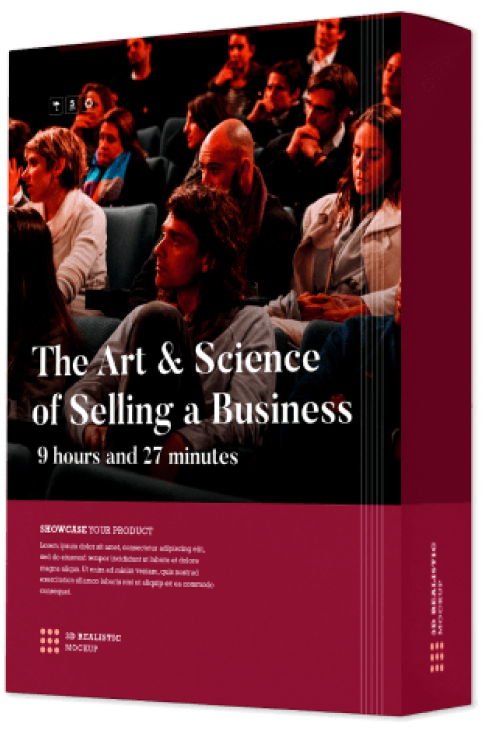Mergers & Acquisitions – They say selling a business is an art – we’ve turned it into a science
Schedule a ConsultationThe Art & Science of Selling a Business
Lessons Learned from 20 Years on Both Sides of the Table
Have you ever wished you could get into the head of the party on the other side of the negotiating table? Here’s your chance.
Join us as we take a deep dive into the sales process with serial entrepreneur Jim Evanger, discussing the perspective of both buyer and seller. Jim has founded, started, operated, and exited multiple middle-market businesses and handled numerous acquisitions as a buyer, giving him deep experience on both sides of the table.
This course contains priceless advice for entrepreneurs of middle-market businesses with revenues up to $100 million. This course wasn’t built on theory. It’s practical advice based on what works in the real world. Listen as Jim shares the lessons he’s learned from over 20 years of experience as both a seller and an acquirer. He’s already made the mistakes, so that you don’t have to. You’ll learn how to avoid the expensive errors that can harm the value of your business or even derail the sales process entirely.
Considering both the buyer’s and seller’s perspectives, we cover the entire sales process, including:
- Deciding to sell
- Preparing your company for sale
- Exploring your exit options
- Valuing your business
- Building your deal team
- Negotiating the letter of intent
- Conducting due diligence
- Determining transaction structure
- Orchestrating the closing
Selling Your Business is a Big Deal
After investing your blood, sweat, and tears into an enterprise that has provided for you, your family and your employees, the moment has finally come for you to start a new chapter in your life.
Meet Your Expert

Jim Evanger
Serial Entrepreneur
- Jim Evanger has founded or led several middle-market and Fortune 100 companies. He has built a successful nationwide franchise brand, which he later sold to a competitor. He has also served as an operating partner for various private equity firms and as interim CEO for several companies.
- During his diverse leadership career, Jim has built executive teams in Fortune 100, middle market, and entrepreneurial start-up businesses. His industry experience spans healthcare, retail, franchising, manufacturing, and private equity. Jim earned his MBA from Northern Illinois University and came up through the ranks at Merck & Co., Inc., beginning as a sales professional. He was promoted into sales management, and before he was 25 years old, he was entrusted with building a team across 33 states and Canada, ultimately becoming Director of Global Business Development.
- After nearly a decade working in corporate America, Jim launched his first business, DOTI Franchising, Inc. which he franchised across the United States and later sold. Since then, Jim has built and led high-performing teams in diverse small to mid-sized businesses, some private-equity owned. This experience helped propel him into various operating partner roles with firms such as Dubin Clark and Latticework Capital, where he sits on boards and advises CEOs on strategy and execution.
What You’ll Learn From This Course
Here are the topics Jim covers in The Art & Science of Selling a Business:
- How to value your business.
- How to build your deal team to guide you through the process.
- What to consider when deciding to sell your business or hold onto it.
- How to build a business that buyers want and are willing to pay top dollar for.
- The most common deal-killers buyers may see in your business and how you can prevent them from killing your deal.
- How to structure your transaction from a tax and legal standpoint.
- How to negotiate the letter of intent.
- Alternatives and options to an outright sale.
- When and how to tell your employees about the sale.
- What factors impact the value of your company, and how you can increase your business’s value.
- The different types of buyers and who is most likely to acquire your company.
- How to plan your exit, including when you should start the planning process, what your plan should include, and how to prioritize your plan.
- Tips on preparing for due diligence.
Course Overview
You’ll find answers to questions including:
Lesson #1: Deciding to Sell
- What are your main objectives in selling your company?
- What do buyers look for?
- The basics of exit planning
- The details of your exit strategy
- De-risking your business
- Prioritizing your plan
Lesson #2: Managing Employees’ Expectations
- Should you tell your employees?
- When do you tell your employees?
- Who do you tell?
- How do you handle the actual discussion?
- When do you introduce the buyer?
- Using a retention bonus with your staff
Lesson #3: How Private Equity Firms Work
- What’s the difference between private and public equity?
- How private equity firms are structured
- How private equity funds work
- What’s the difference between private equity and venture capital?
- What are the different types of investments private equity firms make?
- The private equity funnel
- How private equity firms structure their acquisitions
- What are private equity firms like to work with?
- Private equity by segment
Lesson #4: Valuation
- Business valuation methods
- Normalizing your financial statements
- What does the price include?
- What is the range of multiples?
- Factors that can affect the valuation
- How transaction structure affects the valuation
- The underwriting and due diligence process
- Maximizing value
Lesson #5: Building Your Deal Team
- Tips for hiring and working with advisors
- Including other entrepreneurs who have sold a business
- Brokers and investment Bankers
- Financial and Wealth Advisors
- Attorneys
- Accountants
Lesson #6: Buyer Types
- Wealthy individuals
- Strategic buyers
- Private equity firms
- Direct competitors
- Family
- Employee Stock Ownership Plans (ESOPs)
- Employees
- Aligning your goals with your buyer type
Lesson #7: Exploring Your Options
- Growth options – self-funding, debt, and equity
- Milking the cow
- Mergers
- Buyouts – 100% sales and less than 100% sales
- Defining your goals
Lesson #8: Letter of Intent
- Letter of intent vs. the purchase agreement
- Key clauses in a letter of intent
- Tips for negotiating the letter of intent
Lesson #9: Due Diligence
- Overview of the due diligence process
- Areas of due diligence
- Tips on preparing for due diligence
- Common problems
- What happens after due diligence is completed
Lesson #10: Transaction Structure and Closing
- Consideration
- Typical deal structure
- Legal deal structure
- Tax implications of the sale
- Overview of the purchase agreement
What People Say
"Dubin Clark and I have been working with Jim for almost 10 years on various projects, and he currently sits on the boards of two different platform companies for us and coaches multiple CEOs. He combines a unique perspective as a successful CEO while also having a strong grasp of how private equity works in his role as operating partner. I trust Jim to do the right thing!''

Brent Paris
Managing partner of Dubin-Clark, a middle-market private equity firm
"Jim is my Operating Board Member for Super Home Services, a Dubin Clark PE portfolio company. As a valued mentor, he has provided me with a wealth of expertise, support, and guidance. He has made a significant impact on our team’s ability to achieve profitable growth and exceed our goals. I’m very fortunate to have him on my Board."

George Godfrey
CEO of Super Home Services, a PE owned platform
"Jim is one of the finest operators and strategic thinkers I have ever had the opportunity to work directly with. During my time on the board of a medical device venture, Jim was the clear choice in our CEO search. Once he came on board, I had the pleasure of working closely with him as we built the business. What stands out most to me is that in addition to his tireless work ethic and enormous acumen, he was able to always bring an air of calm to the frequently stressful situations that come with leadership. The relationships that Jim was able to build and foster both down through the organization and back up to the board, allowed him to be the steady hand at the wheel during critical times. I have also maintained a personal relationship with Jim over the years. As fine as he is professionally, he is a better man. I would not hesitate to recommend Jim for any pursuit."

Chris Prince
Former board member of RSS Division at SomnoMed
Purchase the Course Now
9 hours and 27 minutes
This course wasn’t built on theory. It’s practical advice based on what works in the real world.
Purchase Now